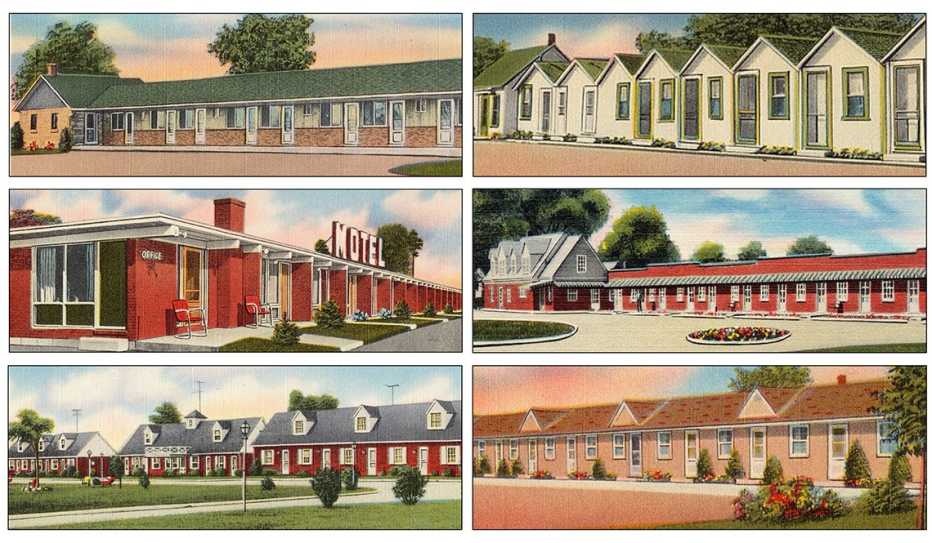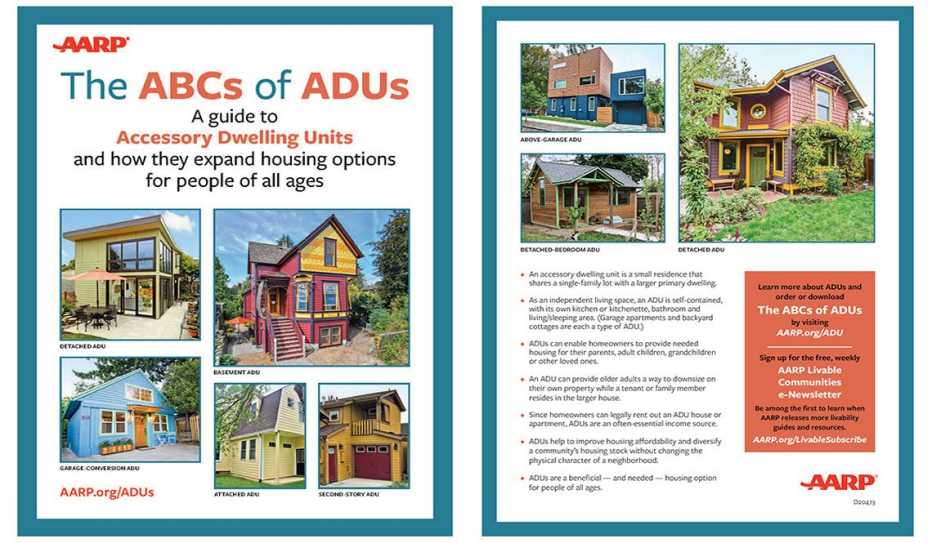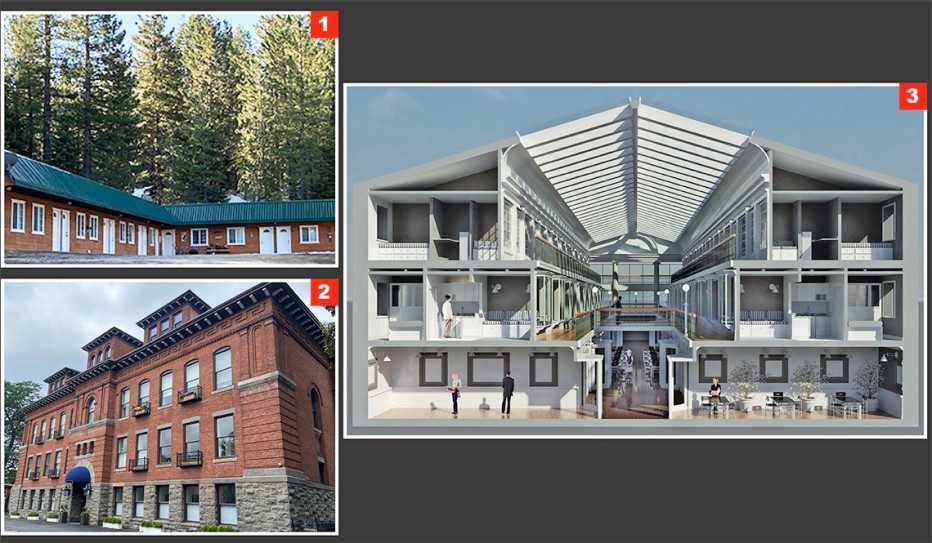Readers Sent Us Their Ideas for a Dream Home and Community for Aging
When Virginia resident Kitty Russell, 69, popped us a note praising The ABCs of ADUs, a free AARP publication about accessory dwelling units, she included a brochure she had created about the kind of later-in-life housing and community she wished she could find for herself. We found Russell's idea interesting and her creativity inspiring, so we published an article about it.


Reimagining Motels
At the end of that piece, we invited readers to share their interesting, inspiring wish or solution — and they did!
- About Kitty Russell's idea, Lydia K., 70, says, "It is exactly, exactly, exactly what I’ve been looking for — preferably in Minnesota or San Antonio, Texas."
- Scott D., age 70-plus, of Sarasota, Florida, wrote that "converting outdated motels into senior living areas is a super idea. Hope it catches on."
- Sandy T. of Roanoke, Virginia, and a former AARP volunteer, writes, "Great idea. Even better, why not repurpose all the idle motels I see in my community as housing for seniors or the homeless? Many have an attached restaurant for social interaction and a pool and exercise room. Most are convenient to public transportation, food, shopping, etc."
- Jeannine T., of Mooresville, North Carolina, popped us a note saying, "Shopping malls are being closed or changed. How about converting them into a 'senior city'?"
- Carol G., 80, of Hunt Valley, Maryland, suggested that unused school buildings be made into housing since "many communities that don't have enough students to fill the schools also don't have enough housing, especially for older people on fixed incomes."
Mansion Living
From: Jessica J., 68 (Ipswich, Massachusetts, and Pearland, Texas)
"I love Kitty Russell’s idea for senior living built around motel concept. That’s great for people who want a concentrated in-town community. Being a country girl, I’d love to see some of the great old estates for sale in my historic New England town be converted into a few senior apartments sharing large living spaces, kitchens and expansive grounds. This would give people downsizing in the area a lovely place to live with a few friends yet still enjoy private country living. Some of these old mansions have 7 or 8 bedrooms and similar number of bathrooms plus staff quarters and guest or carriage houses. Converting one to apartments would be relatively easy. Plus, it would allow these old places to continue and preserve the land as green space. Most of these huge estates are five minutes from a town. This is not a new idea since it’s been done nearby. The condos are very desirable and are snapped up as soon as they become available."
Actually Making a Motel a Home
From: Susan M., 73 (Portola, California)
"Converting a motel into senior housing is not just an idea, we have put this idea into practice on a small scale! In March 2020 it was necessary to put my brother into assisted living for recovery from a medical problem. By the end of the month, the COVID-19 pandemic had been declared, and his nice, friendly residence was put into lockdown. He didn't get to enjoy the freedom we were expecting. No more bus tours or outings, no communal gatherings. They did their best, but it just wasn't appealing. My brother became fearful of dying from COVID. He repeatedly told me so over the phone because I wasn't allowed to visit. He didn't want to die there.
The Solution: We purchased a small motel — the Lake Davis Resort — in northern California. We figured a motel room was about as big as an assisted living studio, and we figured that if we could rent enough of the other rooms to the general public, we could pay the bills and also save the $3,145 monthly fee for assisted living. As a bonus, the resort had four cabins, two of which we have used for other family. My brother, who is now 83, has since recovered and is ready to get back to more independent living.
Exit Plan: We hope to sell to someone who can make the property available for other seniors who want some independence but can't afford the other options. The resort is walking distance to a fishing lake and a small convenience store. The nearby community has helpful neighbors, a library, a senior meal served at the veteran's hall, and a railroad museum that is always looking for volunteers."
Another Motel-As-Home 'Wish List'


Accessory Dwelling Units
Learn about ADUs and order or download our free publications.
From: Nancy M., 73 (Los Angeles, California)
"I would love to live in a motel for older folks. Right now, I'm living in a 450-square-foot apartment, similar to the studio floor plan in the article, located in an inexpensive neighborhood that I can't afford. I have applied to be on wait lists for affordable senior housing. Most of them are either closed, or open for a few days every 5 to 10 years, and those who get on the lists usually wait another 5 to 10 years for an apartment to open. I've modified Kitty Russell's desirable features to match my own: to have cats welcome and no loud, barking dogs allowed; to have a room with a view and a swimming pool for those of us who rely on using it for exercise because walking isn't an option; to live in the city in a safe and clean area; to have my own private place in a building that is well-maintained by management; to have a good place to park my car and other transportation options when needed; to have secure and reliable cable/internet access; to be close to shopping for groceries and supplies; to be within a reasonable distance from my medical group; and to have housing at a price I can afford!"
Safety and Simplicity
From: Martha G., 66 (Sacramento, California)
"I really like the motel idea described in the article for all the reasons Kitty Russell listed plus the fact that it would be more affordable. So many senior communities have a lot of expensive bells and whistles, pricey amenities that a lot of us don't especially want or need. What is needed is a comfortable, quiet, safe living place including most all the features listed in the article. (I am concerned about the desire to have "neighbors of all ages" simply because increases the likelihood of noise, crime, etc., that many seniors want to escape.) The following features are most important to me: to have my own place, but for someone else to maintain it; to have transportation options — and a place to park my car; to have housing available at a price I'm willing and able to pay."
A Cozy Community
From: Deborah F., 71 (Fort Myers, Florida)
"I've had an idea about a workable retirement community consisting of approximately 20 small, simple studio or one-bedroom cottages with minimal kitchen facilities (fridge, microwave, sink) clustered around a central building that would house a general community area, dining area, kitchen and nursing facility (not a hospital or inpatient center, more like a clinic) to help with everyday health issues. The staff would consist of residential services personnel, such as cooks (possibly servers if necessary) and healthcare professionals. Also, some maintenance personnel for repairs and grounds upkeep. Residents could use the general area facilities or not depending on their ability to live independently. All of the buildings would be ground level and would have paths connecting them. The grounds would be suitably landscaped with flowers and seating areas and there would also be a vegetable garden."


Creative Conversions
Some of our readers' solutions already exist in some forms in some places, but these options and more are needed in more places and at more price points.
- Motel housing at the Lake Davis Resort in Portola, California (learn more below).
- A former school building (c. 1903) in Saratoga Springs, New York, now contains condominium apartments.
- Located in Providence, Rhode Island, and recognized as the nation's first enclosed shopping mall (est. 1828), The Arcade fell into disuse in the late 20th century. In 2013, the building was revitalized with retail limited to the street-level and micro apartments — ranging from 225 to 300 square feet — added to the upper floors.
Page published July 2023


Reimagining Motels
"Converting a motel into senior housing is not just an idea, we have put this idea into practice on a small scale! In March 2020 it was necessary to put my brother into assisted living for recovery from a medical problem. By the end of the month, the COVID-19 pandemic had been declared, and his nice, friendly residence was put into lockdown. He didn't get to enjoy the freedom we were expecting. No more bus tours or outings, no communal gatherings. They did their best, but it just wasn't appealing. My brother became fearful of dying from COVID. He repeatedly told me so over the phone because I wasn't allowed to visit. He didn't want to die there.
The Solution: We purchased a small motel — the Lake Davis Resort — in northern California. We figured a motel room was about as big as an assisted living studio, and we figured that if we could rent enough of the other rooms to the general public, we could pay the bills and also save the $3,145 monthly fee for assisted living. As a bonus, the resort had four cabins, two of which we have used for other family. My brother, who is now 83, has since recovered and is ready to get back to more independent living.
Exit Plan: We hope to sell to someone who can make the property available for other seniors who want some independence but can't afford the other options. The resort is walking distance to a fishing lake and a small convenience store. The nearby community has helpful neighbors, a library, a senior meal served at the veteran's hall, and a railroad museum that is always looking for volunteers."
Another Motel-As-Home 'Wish List'


Accessory Dwelling Units
Learn about ADUs and order or download our free publications.
From: Nancy M., 73 (Los Angeles, California)
"I would love to live in a motel for older folks. Right now, I'm living in a 450-square-foot apartment, similar to the studio floor plan in the article, located in an inexpensive neighborhood that I can't afford. I have applied to be on wait lists for affordable senior housing. Most of them are either closed, or open for a few days every 5 to 10 years, and those who get on the lists usually wait another 5 to 10 years for an apartment to open. I've modified Kitty Russell's desirable features to match my own: to have cats welcome and no loud, barking dogs allowed; to have a room with a view and a swimming pool for those of us who rely on using it for exercise because walking isn't an option; to live in the city in a safe and clean area; to have my own private place in a building that is well-maintained by management; to have a good place to park my car and other transportation options when needed; to have secure and reliable cable/internet access; to be close to shopping for groceries and supplies; to be within a reasonable distance from my medical group; and to have housing at a price I can afford!"
Safety and Simplicity
From: Martha G., 66 (Sacramento, California)
"I really like the motel idea described in the article for all the reasons Kitty Russell listed plus the fact that it would be more affordable. So many senior communities have a lot of expensive bells and whistles, pricey amenities that a lot of us don't especially want or need. What is needed is a comfortable, quiet, safe living place including most all the features listed in the article. (I am concerned about the desire to have "neighbors of all ages" simply because increases the likelihood of noise, crime, etc., that many seniors want to escape.) The following features are most important to me: to have my own place, but for someone else to maintain it; to have transportation options — and a place to park my car; to have housing available at a price I'm willing and able to pay."
A Cozy Community
From: Deborah F., 71 (Fort Myers, Florida)
"I've had an idea about a workable retirement community consisting of approximately 20 small, simple studio or one-bedroom cottages with minimal kitchen facilities (fridge, microwave, sink) clustered around a central building that would house a general community area, dining area, kitchen and nursing facility (not a hospital or inpatient center, more like a clinic) to help with everyday health issues. The staff would consist of residential services personnel, such as cooks (possibly servers if necessary) and healthcare professionals. Also, some maintenance personnel for repairs and grounds upkeep. Residents could use the general area facilities or not depending on their ability to live independently. All of the buildings would be ground level and would have paths connecting them. The grounds would be suitably landscaped with flowers and seating areas and there would also be a vegetable garden."


Creative Conversions
Some of our readers' solutions already exist in some forms in some places, but these options and more are needed in more places and at more price points.
- Motel housing at the Lake Davis Resort in Portola, California (learn more below).
- A former school building (c. 1903) in Saratoga Springs, New York, now contains condominium apartments.
- Located in Providence, Rhode Island, and recognized as the nation's first enclosed shopping mall (est. 1828), The Arcade fell into disuse in the late 20th century. In 2013, the building was revitalized with retail limited to the street-level and micro apartments — ranging from 225 to 300 square feet — added to the upper floors.
Page published July 2023


Accessory Dwelling Units
Learn about ADUs and order or download our free publications.
A Cozy Community
From: Deborah F., 71 (Fort Myers, Florida)
"I've had an idea about a workable retirement community consisting of approximately 20 small, simple studio or one-bedroom cottages with minimal kitchen facilities (fridge, microwave, sink) clustered around a central building that would house a general community area, dining area, kitchen and nursing facility (not a hospital or inpatient center, more like a clinic) to help with everyday health issues. The staff would consist of residential services personnel, such as cooks (possibly servers if necessary) and healthcare professionals. Also, some maintenance personnel for repairs and grounds upkeep. Residents could use the general area facilities or not depending on their ability to live independently. All of the buildings would be ground level and would have paths connecting them. The grounds would be suitably landscaped with flowers and seating areas and there would also be a vegetable garden."


Creative Conversions
Some of our readers' solutions already exist in some forms in some places, but these options and more are needed in more places and at more price points.
- Motel housing at the Lake Davis Resort in Portola, California (learn more below).
- A former school building (c. 1903) in Saratoga Springs, New York, now contains condominium apartments.
- Located in Providence, Rhode Island, and recognized as the nation's first enclosed shopping mall (est. 1828), The Arcade fell into disuse in the late 20th century. In 2013, the building was revitalized with retail limited to the street-level and micro apartments — ranging from 225 to 300 square feet — added to the upper floors.
Page published July 2023


Creative Conversions
Some of our readers' solutions already exist in some forms in some places, but these options and more are needed in more places and at more price points.
- Motel housing at the Lake Davis Resort in Portola, California (learn more below).
- A former school building (c. 1903) in Saratoga Springs, New York, now contains condominium apartments.
- Located in Providence, Rhode Island, and recognized as the nation's first enclosed shopping mall (est. 1828), The Arcade fell into disuse in the late 20th century. In 2013, the building was revitalized with retail limited to the street-level and micro apartments — ranging from 225 to 300 square feet — added to the upper floors.


